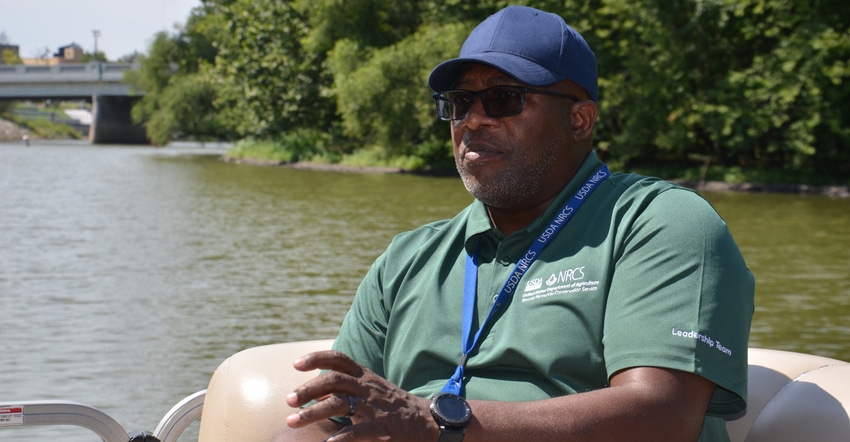
Why do you care what is in the water that flows into Eagle Creek in Hendricks County or the St. Joseph River in Allen County? Indiana State Conservationist Jerry Raynor believes it’s important for both farmers and nonfarmers to care, no matter where they live. Eagle Creek Reservoir is one of the sources of drinking water for Indianapolis. Water from the St. Joseph River supplies drinking water to residents in Fort Wayne.
“Everybody needs to take ownership of issues related to water quality, especially when it involves drinking water,” says Raynor, with the Natural Resources Conservation Service. Raynor recently received a firsthand look at efforts underway to improve water quality in northeastern Indiana. Greg Lake with the Allen County Soil and Water Conservation District invited him to take a ride along the three rivers that converge in the city of Fort Wayne — the St. Joseph, St. Mary and Maumee rivers.
Raynor climbed aboard a boat piloted by Dan Wire with the Maumee Watershed Alliance. The Maumee River feeds into the Lake Erie Basin. Algal blooms in Lake Erie that affect drinking water for Toledo, Ohio, have increased concerns about water quality for tributaries flowing into it.
The city of Fort Wayne is in the middle of a program to drastically reduce sewage discharge into the rivers, and to enhance both water quality and aesthetics along the rivers, which run through the middle of the city. Ratepayers who use water supplied by the city are paying for the improvements to minimize sewer discharge.
“The citizens served by the city have a stake in this because they are ratepayers,” Raynor says. “It’s all about education. The farmers and landowners which NRCS serves need to realize that those who live in the city are sharing the burden through increased rates. Urban dwellers need to know that farmers are making commitments, too.”
Agriculture’s contribution
Raynor notes that farmers who no-till and plant cover crops are helping solve water quality problems.
“If farmers and landowners can take steps to limit soil runoff and prevent nutrients from reaching waterways which feed these rivers, that helps reduce how much utilities must spend to clean up the water used for drinking,” he says. “Everybody has a stake in this, and we can be more productive if everyone works together.”
Programs and funds supplied by NRCS nationally and distributed through NRCS in Indiana are contributing to various watershed projects and combined efforts to get more conservation on the ground in the watersheds feeding into the Lake Erie Basin, Raynor says. When he was on the boat traveling up and down the rivers through downtown Fort Wayne, he saw firsthand how some of those efforts are paying off in cleaner water coming into the rivers.
Raynor knows there is still a long way to go. He encourages farmers who have a chance to ride a boat on the rivers in Fort Wayne, or perhaps to visit municipal water supplies in other parts of the state, to take advantage of the opportunity.
“You definitely get a different perspective once you see what cooperation and dedication to improvements can do,” he says. “Farmers need to see this, and city people who live in these cities need to see how water quality can be improved, too. We all benefit when we cooperate.”
About the Author(s)
You May Also Like




